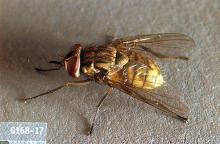Stomoxys calcitrans
Biology The stable fly is a very serious economic biting fly pest for confined cattle throughout the US and is becoming a serious pest for pastured cattle as well. Both sexes suck blood and prefer to feed on the lower body and legs of cattle. If enough flies are present, this may lead to reduced weight gains or milk production in dairy cows. Annual economic loss in North America due to stable flies is estimated at nearly $1 billion. Stable flies breed in many wet places, including old manure, decaying feed, calf bedding, compost, silage, etc. Stable flies will also disperse long distances from where they were bred and become significant pests of humans. The generally agreed upon economic threshold for cattle is 5 flies per leg, at which point beef cattle show reduced weight gains. Similar effects likely occur in milking cows. Management of stable flies is principally through improved sanitation and manure management. When sanitation measures are not enough to control adult populations, application of insecticides to premises or animal quarters may be necessary (see "Fly Control" section). There are some on-animal chemical control options, listed below.
Management-chemical control
Ear tags, strips
- permethrin ear tag (GardStar Plus)-Apply one tag per ear on all animals when flies first appear in spring. Remove before slaughter.
- zeta-cypermethrin/piperonyl butoxide ear tag (PYthon; PYthon II; PYthon MagnuM)-Apply two tags per head of all animals at least 3 months old when flies appear in spring. Remove tag at the end of fly season or before slaughter. Do not use concurrently with insecticide dusts containing zeta-cypermethrin.
Pour-ons, sprays
- dichlorvos spray, concentrate (Vapona [40.2%]; Nuvan Fog2EC [25%], Fog4EC [41.4%], Fog5%;)-Dilute to 1% solution (follow label directions) and apply 1 to 2 fl oz of solution per animal (per day) as a fine mist spray. Do not wet hide. Do not treat calves under 6 months of age. Do not apply within 1 day of slaughter.
- dichlorvos/piperonyl butoxide/pyrethrins (Prozap VIP Insect Spray)-Apply 1 to 2 oz to each animal, proportional to size. Do not soak the skin or wet the hide. Do not apply more than once per day.
- diflubenzuron/permethrin pour-on (Clean-Up II; Lice-Ban)-Apply 3 mL per 100 lb body weight to maximum of 30 mL. Retreat as needed, but no more than once every 2 weeks.
- permethrin spray, ready-to-use (various manufacturers; 0.25%-1%)-Spray animal as directed.
- permethrin spray, concentrate (various manufacturers; 10%-40%)-Dilute in water as directed. Spray animal as directed. Typical application interval is 14 days, as needed, but follow label.
- permethrin pour-on (various manufacturers; 1%-10%)-Apply to animal as directed. Typical application interval is 14 days, as needed, but follow label.
- permethrin/piperonyl butoxide spray, ready-to-use (various manufacturers; 1%)-Apply to animal as directed. Typical application interval is 14 days, as needed, but follow label.
- permethrin/piperonyl butoxide spray, concentrate (various manufacturers; 10%)-Dilute in water as directed. Spray animal as directed. Typical application interval is 14 days, as needed, but follow label.
- permethrin/piperonyl butoxide pour-on (various manufacturers; 0.125%-10%)-Apply to animal as directed. Typical application interval is 14 days, as needed, but follow label.
- pyrethrins spray (PyGanic Livestock & Poultry Insecticide; PyGanic Specialty)-Dilute as directed. Apply 1 quart per adult animal to thoroughly wet hair. Repeat treatment each week as needed. Do not exceed 1 treatment per day. This organic product is OMRI listed.
- pyrethrins spray (Tersus 5%)-Dilute in water as directed. Apply to wet hair thoroughly. Repeat treatment as needed, but do not apply more than once per day.
- pyrethrins/piperonyl butoxide spray, ready-to-use (various manufacturers; 0.1%-0.5%)-Apply to animal as directed. Typically, treat daily as necessary but follow label for treatment interval.
- pyrethrins/piperonyl butoxide spray, concentrate (various manufacturers; 0.96%-6%)-Dilute in water or oil as directed. Spray animal as directed. Typically, treat daily as necessary but follow label for treatment interval.
- pyrethrins/piperonyl butoxide/N-octyl bicycloheptene dicarboximide spray (SSI-50)-Spray entire animal from two-foot distance as it's being released to pasture.
- pyrethrins/permethrin/piperonyl butoxide spray (Pystol Farm & Dairy Aerosol)-Thoroughly spray entire animal for 2 to 4 seconds from approximately 2 ft away.
- pyrethrins/permethrin/piperonyl butoxide spray (Raze) -Spray about 3 seconds per side. Do not spray into eyes. Repeat treatment when flies are troublesome.
- rosemary oil/peppermint oil spray (Essentria All Purpose)-Mix 1 to 3 oz per gal water or mineral oil. Spray directly on animal in amounts to sufficiently cover. Apply the spray at least 20 minutes prior to milking or after milking has been completed.
- soybean oil/peppermint oil/cinnamon oil/lemongrass oil/garlic oil (Purely Green Bio-Pesticide Super Concentrate)-Dilute product at 1 to 2 fl oz per gal water.
Backrubbers (oil)
- permethrin (various manufacturers; 1%-40%)-Use undiluted or dilute in oil as directed. Recharge as needed.
- permethrin/piperonyl butoxide (various manufacturers; 0.125%-10%)-Use undiluted or dilute in oil as directed. Recharge as needed.
Dusts
- zeta-cypermethrin/piperonyl butoxide dust (PYthon Dust; PYthon II Dust)-Directly apply 2 oz per animal. Make sure to apply dust to legs. Repeat as needed but not more than once every 3 days. Do not use dusts concurrently with insecticide ear tags containing zeta-cypermethrin or cypermethrin.
Feed supplements (prevent development of flies in the manure of treated cattle)
- diflubenzuron feed supplement (ClariFly 0.04%; ClariFly 0.67%; ClariFly 8%; JustiFly 3%)- Mix into grain according to label to provide 0.1 mg ai/kg (4.55 mg/100 lb) body weight per day (follow table on label). Start feeding early in spring before flies appear and discontinue when cold weather limits fly activity.
- diflubenzuron mineral tub (Vitalix #5 ClariFly Tub)-Provide free choice with targeted consumption of 1.6 oz per 100 lb of cow per day (~one tub per 15-25 head). Provide before flies appear until end of fly season.
- tetrachlorvinphos feed supplement (Rabon 7.76)-Include in diet or supplement at 70 mg per 100 lb body weight daily. See Mixing Guide for additional details.


